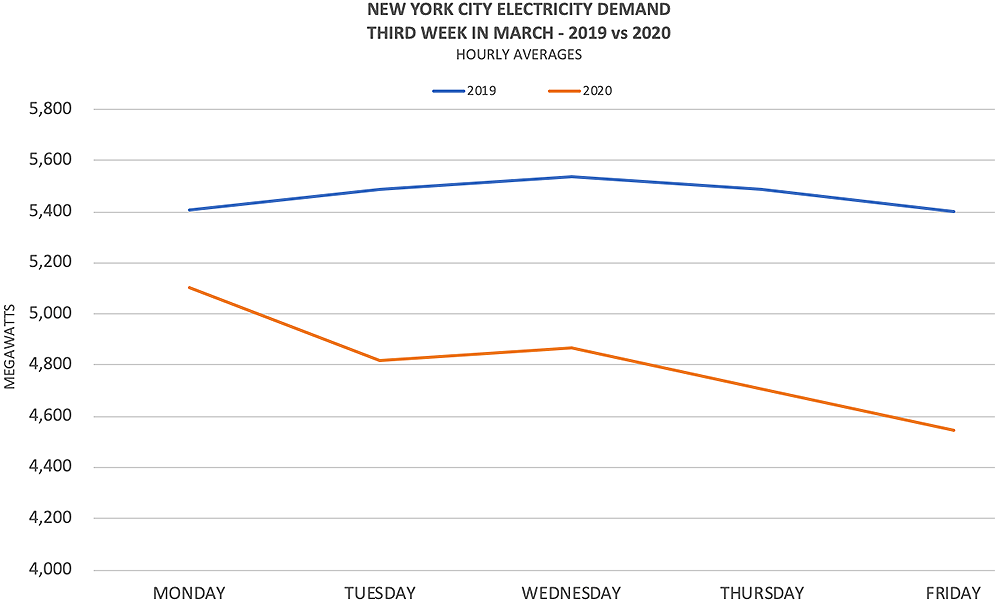Oil is not alone in being hit by the “stay-at-home” policies of the coronavirus pandemic; electricity is also seeing a demand reduction and a shift in peak load. New York City is being hit the hardest. The New York Independent System Operator indicates that the average hourly electricity load or demand in New York’s five boroughs for the five-day workweek beginning March 23 was 4,808 megawatts—a 12 percent drop compared with the same period last year. That was the first week of Governor Cuomo’s lockdown. So far, the demand reduction in other cities and areas has been less.

New York State
According to the New York Independent System Operator, daily peak power demand was trending about 4 percent lower than is typical for this time of year in the state. The week prior to the lockdown, daily energy use declined around 2 to 3 percent statewide. In the first week of the stay-at-home order, the decline was roughly doubled to 4 to 5 percent.
As confirmed cases mount, the New York grid operators are living on-site at control rooms to ensure the state’s power continues. If those operators become overwhelmed, the NY independent system operator will have the local utilities—Consolidated Edison and National Grid–operate the system. The New York City utility, Consolidated Edison, has 188 cases of the coronavirus out of its 13,236 employees. Three have died and 20 have returned to work.
Other Areas
Electricity demand is expected to be down 5 percent in the Southeast, despite fewer statewide stay-at-home policies than most other regions. Electricity demand in New England and California was down the same percentage. Power demand in the Northeast and in the PJM Interconnection, which serves 13 Mid-Atlantic and Midwest states and the District of Columbia, was down 4 percent. The Southwest Power Pool and Southwest region had smaller declines.
Commonwealth Edison Company, whose system is centered on Chicago, saw power demand down 4 percent—less than New York City’s demand reduction. The lower rate for Commonwealth Edison reflects a diverse customer base that also includes a higher percentage of residential customers across most of northern Illinois.
The Midcontinent Independent System Operator, which manages a section of the grid through the central United States, saw overall demand down about 3.8 percent for the week beginning March 22, and it has continued to slip since then because of more state shutdowns.
Electricity demand in the Electric Reliability Council of Texas showed a 2 percent drop in weekly energy use for the week beginning March 22 and little impact on daily peaks. The extent of slower oil drilling has not yet shown up in the numbers.
Further Changes Expected
The impact of the coronavirus on U.S. electric utilities continues to change, with the number of states with stay-at-home policies at 42. Some rural states—Arkansas, Iowa, Nebraska, and North Dakota—do not have statewide stay-at-home orders in place as of April 10. A few others have only partial orders, issued locally by cities or counties. The number of Americans under instructions to stay at home has increased in recent weeks, now accounting for 95 percent of the U.S. population.
According to a 2018 Bureau of Labor Statistics survey, about 30 percent of Americans have jobs that are possible to do from home. That number is likely to be higher today as the internet economy has continued to grow and companies have been forced to adapt to self-quarantine guidelines.
The advancements in medical science over decades have been fueled by electricity, making experimentation and innovation possible and powering the sophisticated equipment we rely on—from complex machines such as the world’s first portable MRI to respirator masks and gloves. Our medical system is dependent on the electric grid and needs reliable and resilient power 24/7. In New York, the city’s single most important source of electricity, the Indian Point nuclear power plant in Westchester County is to be permanently shuttered. By the end of April, one of the two reactors at the 2,069-megawatt facility will stop producing power and the remaining reactor will be shuttered next April. Indian Point provides about 25 percent of the electricity consumed in New York City. Closing the plant will reduce the resilience of New York’s electric grid and increase the state’s reliance on natural gas for electricity production, which could be in short supply due to Governor Cuomo’s ban on fracking and his stance on not approving new natural gas pipelines in the state.
Conclusion
Like oil, electricity is seeing downturns in demand from the coronavirus pandemic, mainly due to “stay-at-home” policies in most states. Some workers are able to work at home, but many non-essential workers are laid off or furloughed, resulting in less use of electricity for them and the businesses which employed them. Nevertheless, the need for affordable and reliable electricity has been exemplified during this outbreak of the coronavirus. Without it, we could not do our jobs, and the virus would have killed far more of our loved ones. The industry is, quite literally, keeping the lights on.



